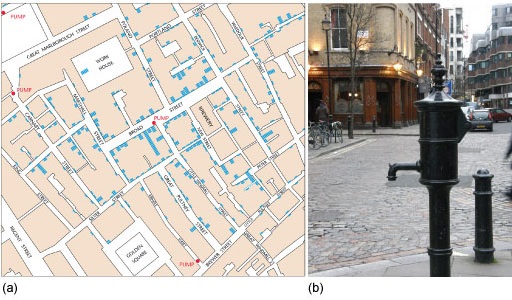2.4 John Snow, cholera and the Broad Street pump
Cholera is a diarrhoeal disease caused by a specific type of bacteria (their Latin name is Vibrio cholerae) that occur naturally in environmental sources of water, such as rivers, lakes and estuaries. Cholera was endemic (always present) in 19th-century England, as it is in many parts of the world today. People infected with cholera bacteria suffer from diarrhoea, which results in rapid dehydration and loss of essential salts from the body. Unless the fluids and salts are rapidly replaced, death follows in about one-third of cases within a few days. In 19th-century London, and in impoverished communities all over the modern world, contamination of drinking water, food, hands and clothes by cholera bacteria shed in the diarrhoea of sufferers is almost impossible to prevent and the disease quickly spreads.
Cholera was first recorded in London in 1831 and numerous outbreaks followed. In 1854 the numbers of cholera cases rose sharply across the city, causing over 850 deaths. No one knew what caused cholera at the time and the health authorities were powerless to halt the epidemic – until Dr John Snow (1813–1858), a London doctor, conducted an experiment that has become not only a classic illustration of the scientific method but also of epidemiology. Epidemiology [eppy-deem-ee-yoll-odjee] is the statistical study of data on the occurrence, distribution, potential causes, prevention and control of diseases, disorders and disabilities (the three Ds) in human populations. Epidemiologists (experts in this discipline) collect and analyse population data to discover ‘Who gets ill and why?’
Snow plotted the deaths from cholera on a map of all the households in the district of London roughly corresponding to modern-day Soho (Figure 7a). He observed that most of the cholera households in this district obtained their water from the pump in Broad Street (Figure 7b). Snow took the simple step of removing the handle from the pump and the local cholera outbreak rapidly subsided. The origins of ‘public health’ as a discipline can be traced back to this experiment. Public health is defined as:
The science and art of promoting and protecting health and well-being, preventing ill-health and prolonging life through the organised efforts of society.

In the next section, you will conduct an activity where you will analyse John Snow’s experiment to identify the features that characterise the ‘scientific method’ of investigation.
